#Denotation and Connotation
Explore tagged Tumblr posts
Text

Jewel Desirose R. De Mayo // 12-J HUMSS @kim1643philo
BAMBOOZLE
Denotation: to deceive by underhanded method or to confuse or throw off thoroughly or completely
Connotation: typically means to deceive or get the better of someone in a cunning or dishonest way. It implies the sense of confusion or bewilderment caused by deception.

SERENDIPITY
Denotation: the occurrence of fortunate or unexpected events by chance, often leading to pleasant and beneficial outcomes.
Connotation: generally positive and carries a sense of happy coincidence, luck, or the discovery of something delightful unexpectedly. It often implies the feeling of joy or contentment associated with fortunate and unplanned events.

INKLING
Denotation: a slight or vague understanding of something.
Connotation: typically neutral or slightly positive. It suggests a sense of curiosity, anticipation, or a faint awareness about something, which can be intriguing or pique one's interest.

EPIPHANY
Denotation: a sudden, profound realization or insight, often accompanied by a sense of clarity or enlightenment.
Connotation: overwhelmingly positive. It carries the sense of transformative and enlightening experience where someone gains profound understandings or insight.

SASHAYING
Denotation: to walk or to move in an elegant, confident, and often exaggerated or flamboyant manner, typically characterized by graceful or swaying movements of the hips and body.
Connotation: generally positive and can imply a sense of confidence, elegance, or even a touch of playfulness.
#practical research#pr2#yasujewels#denotation#connotation#denotation and connotation#school#grammar#definitions
3 notes
·
View notes
Text
The Philosophy of Semiotics
The philosophy of semiotics explores the study of signs and symbols, their meaning, and how they function in communication. Semiotics is concerned with understanding how meaning is constructed and interpreted in various forms of communication, whether linguistic, visual, or cultural. This field intersects with linguistics, philosophy, anthropology, and psychology, examining the processes by which signs represent objects, ideas, or concepts.
Key Themes in the Philosophy of Semiotics:
Definition of Signs:
Signs and Symbols: In semiotics, a sign is anything that communicates a meaning beyond itself. Signs can be words, images, sounds, gestures, or objects. A symbol is a type of sign that represents something by convention or agreement, such as a flag representing a country.
Sign Components: A sign typically consists of two components: the signifier (the form the sign takes, such as a word or image) and the signified (the concept or meaning it represents). The relationship between these components is central to semiotic analysis.
Semiotic Theories:
Ferdinand de Saussure: Saussure, a Swiss linguist, is one of the founding figures of semiotics. He introduced the idea of the sign as composed of the signifier and signified, and emphasized that the relationship between them is arbitrary and based on social conventions. His work laid the foundation for structuralism.
Charles Sanders Peirce: An American philosopher, Peirce developed a triadic model of the sign, consisting of the representamen (the form of the sign), the interpretant (the meaning derived by the interpreter), and the object (the actual thing to which the sign refers). Peirce’s model is more dynamic and process-oriented than Saussure’s.
Roland Barthes: A French literary theorist, Barthes extended semiotics into cultural studies, exploring how myths and ideologies are constructed through signs. He analyzed how everyday objects and media convey broader cultural meanings.
Sign Systems:
Language as a Sign System: Language is the most studied sign system in semiotics. It is composed of linguistic signs (words), which are used to communicate complex ideas and emotions. Semiotics examines how language operates as a system of signs and how meaning is structured within this system.
Non-Linguistic Signs: Semiotics also studies non-linguistic sign systems, such as visual art, music, clothing, architecture, and even body language. These systems, like language, rely on conventions and cultural contexts to convey meaning.
Signification and Meaning:
Denotation and Connotation: Semiotics distinguishes between denotation (the literal meaning of a sign) and connotation (the associated or implied meanings). For example, a red rose denotatively signifies a type of flower, but it connotatively signifies love or passion.
Polysemy: Many signs are polysemous, meaning they have multiple meanings depending on context. Semiotics explores how the same sign can be interpreted differently in various cultural, social, or personal contexts.
Structuralism and Post-Structuralism:
Structuralism: Structuralism, influenced by Saussure, is an approach that analyzes cultural phenomena as systems of signs governed by underlying structures. It seeks to understand how meaning is produced within these structures, emphasizing the role of binary oppositions (e.g., good/evil, male/female) in organizing meaning.
Post-Structuralism: Post-structuralist thinkers like Jacques Derrida and Michel Foucault challenged the fixed relationships between signifier and signified proposed by structuralism. They argued that meaning is unstable, context-dependent, and subject to continual reinterpretation and deconstruction.
Semiotics in Cultural and Media Studies:
Myth and Ideology: Semiotics is used to analyze how myths, ideologies, and cultural narratives are constructed and maintained through signs. Barthes’ concept of myth explores how dominant cultural values are naturalized through everyday signs.
Media and Representation: Semiotics is a critical tool in media studies, helping to deconstruct how media texts (films, advertisements, news, etc.) produce and manipulate meaning. It examines how representations shape public perception and reinforce power structures.
Philosophical Implications:
Reality and Representation: Semiotics raises philosophical questions about the nature of reality and our ability to represent it through signs. If our understanding of the world is mediated by signs, then our perception of reality is always interpretative, never direct.
Subjectivity and Interpretation: The interpretation of signs is influenced by individual subjectivity, cultural background, and context. This challenges the notion of objective meaning and emphasizes the role of the interpreter in creating meaning.
Applications of Semiotics:
Advertising and Marketing: Semiotics is widely used in advertising to create powerful and persuasive messages. By understanding how signs operate, advertisers craft messages that resonate with consumers’ desires and cultural values.
Literary Criticism: In literary theory, semiotics is used to analyze texts, uncovering the layers of meaning embedded in language, symbols, and narrative structures.
Anthropology and Sociology: Semiotics informs the study of cultural rituals, practices, and artifacts, offering insights into how societies construct and convey meaning.
The philosophy of semiotics provides a framework for understanding how meaning is created, communicated, and interpreted through signs. It reveals the complexities of language, culture, and communication, showing how signs shape our perception of reality and our interactions with the world. By analyzing the structures and systems of signs, semiotics offers deep insights into the workings of human thought, culture, and society.
#philosophy#epistemology#knowledge#learning#education#chatgpt#ontology#Philosophy of Semiotics#Sign Theory#Ferdinand de Saussure#Charles Sanders Peirce#Structuralism#Post-Structuralism#Signifier and Signified#Denotation and Connotation#Cultural Semiotics#Language and Meaning#Media and Representation#Myth and Ideology#Reality and Representation#Interpretation and Subjectivity#Non-Linguistic Signs#Communication Studies#Semiotic Analysis
1 note
·
View note
Text
My favourite example of the distinction between denotation and connotation is "what did you do?" versus "what have you done?"
2K notes
·
View notes
Text
Once again if you don’t know what this is about, spare yourself…
It’s not about the word “gringo” itself, goddamnit!!
It’s about people telling Black Americans “you’re a privileged westerner” as an excuse to invalidate their voices. It’s about being willfully ignorant towards the literal centuries of oppression towards Black Americans to win a stupid internet argument.
The people saying these things do not understand what it’s like to be a minority in your own country. No one is denying that westerners have privilege but being an immigrant or a POC in a majority white country is a vastly different experience than being a white person in that country.
#please go back to school and learn about connotation and denotation again.#you can use words that aren’t inherently offensive in an offensive way#I.e. ‘He is an immigrant’ vs ‘those goddamn illegal immigrants are stealing our jobs’#it’s not about the word it’s about the disrespect. this isn’t a etymology debate ffs
8 notes
·
View notes
Text
"The truth is not simply that words originally innocent tend to acquire a bad sense. The truth is that words originally descriptive tend to become terms either of mere praise or of mere blame.
The vocabulary of flattery and insult is continually enlarged at the expense of the vocabulary of definition. As old horses go to the knacker's yard, or old ships to the breakers, so words in their last decay go to swell the enormous list of synonyms for good and bad.
𝐀𝐧𝐝 𝐚𝐬 𝐥𝐨𝐧𝐠 𝐚𝐬 𝐦𝐨𝐬𝐭 𝐩𝐞𝐨𝐩𝐥𝐞 𝐚𝐫𝐞 𝐦𝐨𝐫𝐞 𝐚𝐧𝐱𝐢𝐨𝐮𝐬 𝐭𝐨 𝐞𝐱𝐩𝐫𝐞𝐬𝐬 𝐭𝐡𝐞𝐢𝐫 𝐥𝐢𝐤𝐞𝐬 𝐚𝐧𝐝 𝐝𝐢𝐬𝐥𝐢𝐤𝐞𝐬 𝐭𝐡𝐚𝐧 𝐭𝐨 𝐝𝐞𝐬𝐜𝐫𝐢𝐛𝐞 𝐟𝐚𝐜𝐭𝐬, 𝐭𝐡𝐢𝐬 𝐦𝐮𝐬𝐭 𝐫𝐞𝐦𝐚𝐢𝐧 𝐚 𝐮𝐧𝐢𝐯𝐞𝐫𝐬𝐚𝐥 𝐭𝐫𝐮𝐭𝐡 𝐚𝐛𝐨𝐮𝐭 𝐥𝐚𝐧𝐠𝐮𝐚𝐠𝐞
This process is going on very rapidly at the moment. The words 'abstract' and 'concrete' were first coined to express a distinction which is really necessary to thought: but it is only for the very highly educated that they still do so.
In popular language 𝘤𝘰𝘯𝘤𝘳𝘦𝘵𝘦 now means something like "clearly defined and practicable"; it has become a term of praise.
𝘈𝘣𝘴𝘵𝘳𝘢𝘤𝘵 means "vague, shadowy, unsubstantial"; it has become a term of reproach.
𝘔𝘰𝘥𝘦𝘳𝘯, in the mouths of many speakers, has ceased to be a chronological term ; it has "sunk into a good sense" and often means little more than "efficient" or in some contexts "kind" ;
𝘊𝘰𝘯𝘷𝘦𝘯𝘵𝘪𝘰𝘯𝘢𝘭 can no longer be used in its proper sense without explanation.
𝘗𝘳𝘢𝘤𝘵𝘪𝘤𝘢𝘭 is a mere term of approval;
To save any word from the eulogistic and dyslogistic abyss is a task worth the efforts of all who love the English language. And I can think of one word—the word 𝘊𝘩𝘳𝘪𝘴𝘵𝘪𝘢𝘯—which is at this moment on the brink.
That is always the trouble about allowing words to slip into the abyss. Once turn 𝘴𝘸𝘪𝘯𝘦 into a mere insult, and you need a new word (pig) when you want to talk about the animal. Once let 𝘴𝘢𝘥𝘪𝘴𝘮 dwindle into a useless synonym for cruelty, and what do you do when you have to refer to the highly special perversion which actually afflicted M. de Sade?
It is important to notice that the danger to the word "Christian" comes not from its open enemies, but from its friends.
It was not egalitarians, it was officious admirers of gentility, who killed the word 𝘨𝘦𝘯𝘵𝘭𝘦𝘮𝘢𝘯. The other day I had occasion to say that certain people were not Christians; a critic asked how I dared say so, being unable (as of course I am) to read their hearts. I had used the word to mean "persons who profess belief in the specific doctrines of Christianity"; my critic wanted me to use it in what he would (rightly) call "a far deeper sense"—a sense so deep that no human observer can tell to whom it applies.
And is that deeper sense not more important? It is indeed ; just as it was more important to be a "real" gentleman than to have coat-armour. But the most important sense of a word is not always the most useful. 𝐖𝐡𝐚𝐭 𝐢𝐬 𝐭𝐡𝐞 𝐠𝐨𝐨𝐝 𝐨𝐟 𝐝𝐞𝐞𝐩𝐞𝐧𝐢𝐧𝐠 𝐚 𝐰𝐨𝐫𝐝'𝐬 𝐜𝐨𝐧𝐧𝐨𝐭𝐚𝐭𝐢𝐨𝐧 𝐢𝐟 𝐲𝐨𝐮 𝐝𝐞𝐩𝐫𝐢𝐯𝐞 𝐭𝐡𝐞 𝐰𝐨𝐫𝐝 𝐨𝐟 𝐚𝐥𝐥 𝐩𝐫𝐚𝐜𝐭𝐢𝐜𝐚𝐛𝐥𝐞 𝐝𝐞𝐧𝐨𝐭𝐚𝐭𝐢𝐨𝐧?
And when, however reverently, you have killed a word you have also, as far as in you lay, blotted from the human mind the thing that word originally stood for.
𝐏𝐞𝐨𝐩𝐥𝐞 𝐝𝐨 𝐧𝐨𝐭 𝐥𝐨𝐧𝐠 𝐜𝐨𝐧𝐭𝐢𝐧𝐮𝐞 𝐭𝐨 𝐭𝐡𝐢𝐧𝐤 𝐰𝐡𝐚𝐭 𝐭𝐡𝐞𝐲 𝐡𝐚𝐯𝐞 𝐟𝐨𝐫𝐠𝐨𝐭𝐭𝐞𝐧 𝐡𝐨𝐰 𝐭𝐨 𝐬𝐚𝐲."
____
C.S. Lewis, 𝘛𝘩𝘦 𝘋𝘦𝘢𝘵𝘩 𝘰𝘧 𝘞𝘰𝘳𝘥𝘴
September 22, 1944
#words#literature#essays#cs Lewis#connotation#denotation#communication#critical thinking#thoughts#language#language dilution#confusion#communication breakdown#ill communication#inklings#vocabulary#writing
5 notes
·
View notes
Text
Play Fair
I was five when I heard the yelling, "Cheating!" my mother’s voice screeched like my pet parrot. But we weren’t playing a board game. And I was alone in the kitchen, just cold spaghetti on the counter. Father’s silence was unusual, and then a door slammed, too hard. It felt like something in me cracked. I didn’t understand. How do you cheat when no one's playing?
At ten, I whispered the answer "Catastrophe" to Ben, because he always let me copy his math homework, and we shared peanut butter crackers and secrets about monsters under our beds. The teacher called it cheating. But I said, "It’s not cheating to help a friend." Still, she marked my name with a red pen that bled through the paper and that crack of guilt grew deeper.
At sixteen, I learned the other kind of cheating, the kind that five year old me had never grasped. The kind that doesn’t come with test scores or teacher scowls, just the susurrus of gossip in the halls, and my girlfriend’s selfish laugh the truth spilling from my best friend's mouth. I asked her if it was true. She didn’t deny it. "It didn’t mean anything," she said, but it meant everything to me.
Now I’m thirty. Married. Two kids. Two jobs. A life of comfort, but most days I just don't feel like me. Her phone lights up with a name I don’t recognize. She turns it over. I turn away.
And here, back in the kitchen, the hum of the fridge drowning the silence. I catch my reflection in the dark glass of the window. I look tired. Like someone who’s played fair for too long. And I wonder... Is it worth the cheating?
#poetic stories#original poem#perspective poem#perspective#word art#word play#connotation#denotation#diction#my writing
4 notes
·
View notes
Text
~
#making the lyric analysis for jet skis on the moat this time and wow that's a song that says too much. no wonder why they don't really#sing it in shows. i mean. the risk of leaking denotative info through the connotative ones is kind of huge#p
3 notes
·
View notes
Text
Mutuals and friends of mutuals: I'm pretty sure one of you somewhere understands Latin conjugation etc? I am trying to alter the phrase "deus ex machina" to mean something along the line of "god outside the universe" (i.e. taking the trope's concept of intervention from outside the story and making it intervention from outside the universe) but Google translate is being expectedly unhelpful
#would greatly appreciate if someone can give pointers!#based on google translate i've come up with the options of 'deus ex universo' and 'deus extra universum'#but i'm pretty sure there's conjugation stuff going on i don't understand with 'universe'#and also that there is possibly some denotation vs connotation confusion with ex vs extra#language
18 notes
·
View notes
Text




KATATOKI Teaser | Yojiro Noda x J.I.D Listen to WONDER BOY'S AKUMU CLUB here !!
#katatoki#野田洋次郎#yojiro noda#j.i.d#wonder boy's akumu club#音楽#gif#my gifs#this may only be a teaser but we do indeed have a full version of katatoki now !!! >:)#i'd been looking forward to this collaboration for so long !#it's better than i could have ever expected#the transition between their verses is so smooth & when yojiro starts singing it's like i can feel all the tension leaving my body#which is interesting considering the loneliness at the center of the song#his voice is equal parts haunting yet breathtaking & really captures that lonely feeling#so good !! it's songs like this one which reaffirm how his voice is my fav to listen to#then we've got full hyper toy !!!!#holding out on us once again i see#when the trailer dropped with a smaller glimpse into hyper toy i was like oh?! but still not the entire scope !#such a banger !!! the build up! that effect that happens right at the end of the 1st verse!#ahhh it makes me want to dance more than any other song on the album#and i think it embodies a kind of love and determination present in so many of the songs#tbh i was a little worried when i saw the track list for the 1st time#bc so many of the titles contained words with negative connotations#denoting sadness & pain & real struggle#and yeah the songs do go all in on those things!#but there's a resounding truth & resilience to them as well#a love for life & music in the face of those hardships#it's really anchored me to the present & i'm not exaggerating when i say this release has made my entire year <3#also the photos/videos coming out from the solo show & afterparty are such a joy to behold 🥹#my heart is swelling with pride & happiness for him 💗
2 notes
·
View notes
Text
Not to belabor the point but there’s something really odd to me about being confused but never pausing to consider if there’s a gap in your own understanding and seeking out more information. Like imagine concluding that everyone else is just using words in literal ways that don’t make sense instead of opening a fucking dictionary app 😭😭😭😭😭
#I’m fairly imaginative person and I still frequently use dictionaries just to confirm my own understanding#especially because like language is complex and weird and lot of times you infer meaning from context#and that meaning might be wrong or it’s connotation is completely different from the denotation or whatever#💚
2 notes
·
View notes
Text
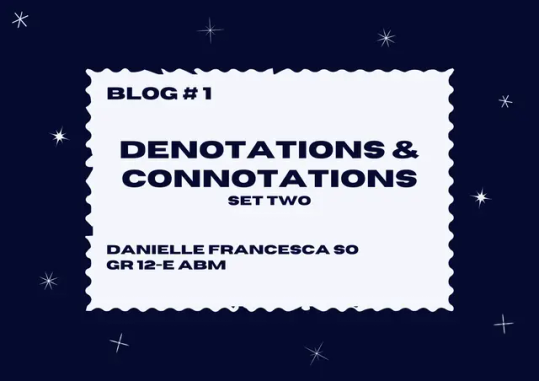
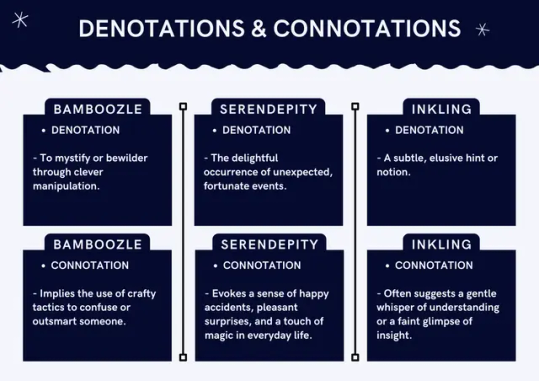
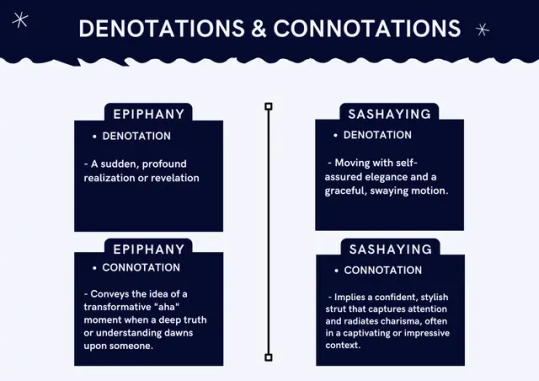
BLOG #1 (RDL 2)
SO, Danielle Francesca P.
GR. 12-E ABM
@kim1643philo
3 notes
·
View notes
Text
Highly considering using it/its pronouns I realized I like it so much more than they/them
Like why are we trying to make this plural word singular when we already have a singular neutral pronoun it's IT but folks aren't ready for that conversation
#half joking about the last part#but for real if were hellbent on changing the accepted meaning of a set of pronouns why not change the connotation of the singular one#it isnt even a denotation there is nothing in the definiton of it that makes it unacceptable to use on a person#honeslty i feel More dehumanized when someone refers to me as they#because i associate they with being used when you dont know the person or when talking about a hypothetical person#but im not hypothetical im real and im a THING i am an it it's okay to be an it
1 note
·
View note
Text
The way I see it there's a denotation and connotation. Dude may have shifted definitions over the years and now its colloquial denotation is just a fun thing to call people or apparently things. However, the connotation is still a masculine term like, "a couple of dudes" makes most people think of a pair of masc presenting individuals. You can try to salvage a term (like the LGBTQIA+ community reclaimed "Queer") but we need to be conscious and open minded to how a term's connotations affect people. They may not hold the same emotions to a word and it may have been used to hurt them before.
Reblog if you have used dude as a non gender specific term.
#please don't call me dude#or bro#I'm not a guy or one of the guys#denotation vs connotation#queer#validate me#trans
443K notes
·
View notes
Text
Week 4 WOII (6 Feb 2025) - Semiotics
I thought Semiotics was an interesting topic as it is quite subjective, and it was intriguing to me to make connections about how we interpret certain things. There is the denotation part, based on what we see, that is more literal. However it was the connotation part which was interesting, as everyone can make their own judgements on what they see.

For example, taking this poster from Mahatma Gandhi hospital, they are trying to show a message that smoking and drinking is similar to being “trapped”. The denotation would be that the cigarettes are shown as jail bars, and you can also see a silhouette of an alcohol bottle around it. However the connotation would be very different. The reason why cigarettes are shown as jail bars is because they want to show that just as inmates are trapped in jail, cigarettes can also have the same effect. The alcohol bottle may not be as prominent, but also enhances the connection to the jail cell concept.
While the poster connotation is pretty literal, some people may not have the same idea. If the caption below was removed, I think that the poster can also be interpreted that cigarettes have the same consequences as drinking perhaps. Both interpretations are valid, and just goes to show that elements of a poster are both inherent to add clarity and meaning to the design.
Overall Semiotics are part and parcel of the design industry, and I think as designers we need to be mindful about the different interpretations that can come out of our works, and how we can make it as clear as possible towards our intended audience.
(Word Count: 275)
0 notes
Text
I get very irrationally annoyed when I have a different answer than someone else for something I consider objective and they go "oh well we just have different opinions!!"
like no actually you are simply incorrect
#this is usually about definitions of words#like i get language is fluid and denotations are just connotations favored by the ruling class#but sometimes Words Mean Things and i'm gonna need you to step back and stop using that word for something it Does Not Mean
1 note
·
View note
Text
I’m going to reblgo your tags as well as this post, if that’s alright.
Your commentary is very insightful! And yes. As a British person I was primarily exposed to Puritans via The Smashings, and banning of Christmas. Good to know there’s more to it.
Why People Are Wrong About the Puritans of the English Civil War and New England
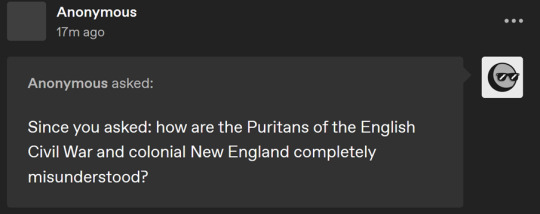



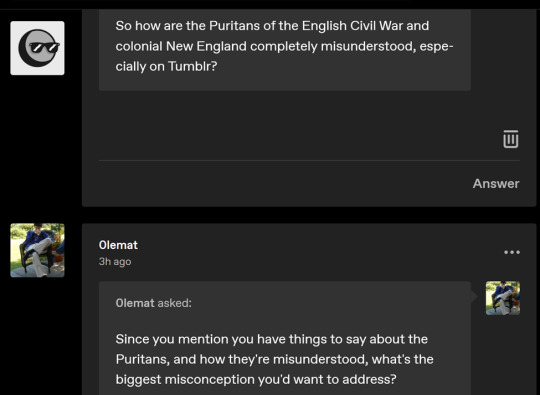
Oh well, if you all insist, I suppose I can write something.
(oh good, my subtle scheme is working...)
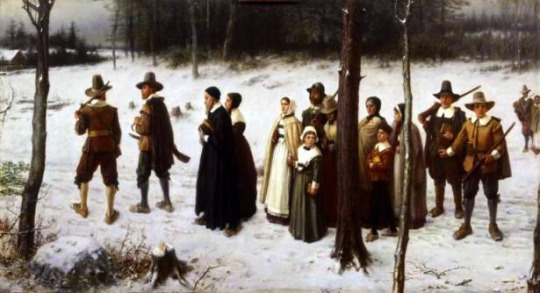
Introduction:
So the Puritans of the English Civil War is something I studied in graduate school and found endlessly fascinating in its rich cultural complexity, but it's also a subject that is popularly wildly misunderstood because it's caught in the jaws of a pair of distorted propagandistic images.
On the one hand, because the Puritans settled colonial New England, since the late 19th century they've been wrapped up with this nationalist narrative of American exceptionalism (that provides a handy excuse for schoolteachers to avoid talking about colonial Virginia and the centrality of slavery to the origins of the United States). If you went to public school in the United States, you're familiar with the old story: the United States was founded by a people fleeing religious persecution and seeking their freedom, who founded a society based on social contracts and the idea that in the New World they were building a city on a hill blah blah America is an exceptional and perfect country that's meant to be an example to the world, and in more conservative areas the whole idea that America was founded as an explicitly Christian country and society. Then on the other hand, you have (and this is the kind of thing that you see a lot of on Tumblr) what I call the Matt Damon-in-Good-Will-Hunting, "I just read Zinn's People's History of the United States in U.S History 101 and I'm home for my first Thanksgiving since I left for colleg and I'm going to share My Opinions with Uncle Burt" approach. In this version, everything in the above nationalist narrative is revealed as a hideous lie: the Puritans are the source of everything wrong with American society, a bunch of evangelical fanatics who came to New England because they wanted to build a theocracy where they could oppress all other religions and they're the reason that abortion-banning, homophobic and transphobic evangelical Christians are running the country, they were all dour killjoys who were all hopelessly sexually repressed freaks who hated women, and the Salem Witch Trials were a thing, right?
And if anyone spares a thought to examine the role that Puritans played in the English Civil War, it basically short-hands to Oliver Cromwell is history's greatest monster, and didn't they ban Christmas?
Here's the thing, though: as I hope I've gotten across in my posts about Jan Hus, John Knox, and John Calvin, the era of the Reformation and the Wars of Religion that convulsed the Early Modern period were a time of very big personalities who were complicated and not very easy for modern audiences to understand, because of the somewhat oblique way that Early Modern people interpreted and really believed in the cultural politics of religious symbolism. So what I want to do with this post is to bust a few myths and tease out some of the complications behind the actual history of the Puritans.
Did the Puritans Experience Religious Persecution?
Yes, but that wasn't the reason they came to New England, or at the very least the two periods were divided by some decades. To start at the beginning, Puritans were pretty much just straightforward Calvinists who wanted the Church of England to be a Calvinist Church. This was a fairly mainstream position within the Anglican Church, but the "hotter sort of Protestant" who started to organize into active groups during the reigns of Elizabeth and James I were particularly sensitive to religious symbolism they (like the Hussites) felt smacked of Catholicism and especially the idea of a hierarchy where clergy were a better class of person than the laity.
So for example, Puritans really first start to emerge during the Vestments Controversy in the reign of Edward VI where Bishop Hooper got very mad that Anglican priests were wearing the cope and surplice, which he thought were Catholic ritual garments that sought to enhance priestly status and that went against the simplicity of the early Christian Church. Likewise, during the run-up to the English Civil War, the Puritans were extremely sensitive to the installation of altar rails which separated the congregation from the altar - they considered this to be once again a veneration of the clergy, but also a symbolic affirmation of the Catholic doctrine of transubstantiation.
At the same time, they were not the only religious faction within the Anglican Church - and this is where the religious persecution thing kicks in, although it should be noted that this was a fairly brief but very emotionally intense period. Archbishop William Laud was a leading High Church Episcopalian who led a faction in the Church that would become known as Laudians, and he was just as intense about his religious views as the Puritans were about his. A favorite of Charles I and a first advocate of absolutist monarchy, Laud was appointed Archbishop of Canturbury in 1630 and acted quickly to impose religious uniformity of Laudian beliefs and practices - ultimately culminating in the disastrous decision to try imposing Episcopalianism on Scotland that set off the Bishop's Wars. The Puritans were a special target of Laud's wrath: in addition to ordering the clergy to do various things offensive to Puritans that he used as a shibboleth to root out clergy with Puritan sympathies and fire them from their positions in the Church, he established official religious censors who went after Puritan writers like William Prynne for seditious libel and tortured them for their criticisms of his actions, cropping their ears and branding them with the letters SL on their faces. Bringing together the powers of Church and State, Laud used the Court of Star Chamber (a royal criminal court with no system of due process) to go after anyone who he viewed as having Puritan sympathies, imposing sentences of judicial torture along the way.
It was here that the Puritans began to make their first connections to the growing democratic movement in England that was forming in opposition to Charles I, when John Liliburne the founder of the Levellers was targeted by Laud for importing religious texts that criticized Laudianism - Laud had him repeatedly flogged for challenging the constitutionality of the Star Chamber court, and "freeborn John" became a martyr-hero to the Puritans.
When the Long Parliament met in 1640, Puritans were elected in huge numbers, motivated as they were by a combination of resistance to the absolutist monarchism of Charles I and the religious policies of Archbishop Laud - who Parliament was able to impeach and imprison in the Tower of the London in 1641. This relatively brief period of official persecution that powerfully shaped the Puritan mindset was nevertheless disconnected from the phenomena of migration to New England - which had started a decade before Laud became Archbishop of Canterbury and continued decades after his impeachment.
The Puritans Just Wanted to Oppress Everyone Else's Religion:
This is the very short-hand Howard Zinn-esque critique we often see of the Puritan project in the discourse, and while there is a grain of truth to it - in the Massachusetts Bay Colony, the Congregational Church was the official state religion, no other church could be established without permission from the Congregational Church, all residents were required to pay taxes to support the Congregational Church, and only Puritans could vote. Moreover, there were several infamous incidents where the Puritan establishment put Anne Hutchinson on trial and banished her, expelled Roger Williams, and hanged Quakers.
Here's the thing, though: during the Early Modern period, every single side of every single religious conflict wanted to establish religious uniformity and oppress the heretics: the Catholics did it to the Protestants where they could mobilize the power of the Holy Roman Emperor against the Protestant Princes, the Protestants did it right back to the Catholics when Gustavus Adolphus' armies rolled through town, the Lutherans and the Catholics did it to the Calvinists, and everybody did it to the Anabaptists.
That New England was founded as a Calvinist colony is pretty unremarkable, in the final analysis. (By the by, both Hutchinson and Williams were devout if schismatic Puritans who were firmly of the belief that the Anglican Church was a false church.) What's more interesting is how quickly the whole religious project broke down and evolved into something completely different.
Essentially, New England became a bunch of little religious communes that were all tax-funded, which is even more the case because the Congregationalist Church was a "gathered church" where the full members of the Church (who were the only people allowed to vote on matters involving the church, and were the only ones who were allowed to be given baptism and Communion, which had all kinds of knock-on effects on important social practices like marriages and burials) and were made up of people who had experienced a conversion where they can gained an assurance of salvation that they were definitely of the Elect. You became a full member by publicly sharing your story of conversion (which had a certain cultural schema of steps that were supposed to be followed) and having the other full members accept it as genuine.
This is a system that works really well to bind together a bunch of people living in a commune in the wilderness into a tight-knit community, but it broke down almost immediately in the next generation, leading to a crisis called the Half-Way Covenant.
The problem was that the second generation of Puritans - all men and women who had been baptized and raised in the Congrgeationalist Church - weren't becoming converted. Either they never had the religious awakening that their parents had had, or their narratives weren't accepted as genuine by the first generation of commune members. This meant that they couldn't hold church office or vote, and more crucially it meant that they couldn't receive the sacrament or have their own children baptized.
This seemed to suggest that, within a generation, the Congregationalist Church would essentially define itself into non-existence and between the 1640s and 1650s leading ministers recommended that each congregation (which was supposed to decide on policy questions on a local basis, remember) adopt a policy whereby the children of baptized but unconverted members could be baptized as long as they did a ceremony where they affirmed the church covenant. This proved hugely controversial and ministers and laypeople alike started publishing pamphlets, and voting in opposing directions, and un-electing ministers who decided in the wrong direction, and ultimately it kind of broke the authority of the Congregationalist Church and led to its eventual dis-establishment.
The Puritans are the Reason America is So Evangelical:
This is another area where there's a grain of truth, but ultimately the real history is way more complicated.
Almost immediately from the founding of the colony, the Puritans begin to undergo mutation from their European counterparts - to begin with, while English Puritans were Calvinists and thus believed in a Presbyterian form of church government (indeed, a faction of Puritans during the English Civil War would attempt to impose a Presbyterian Church on England.), New England Puritans almost immediately adopted a congregationalist system where each town's faithful would sign a local religious constitution, elect their own ministers, and decide on local governance issues at town meetings.
Essentially, New England became a bunch of little religious communes that were all tax-funded, which is even more the case because the Congregationalist Church was a "gathered church" where the full members of the Church (who were the only people allowed to vote on matters involving the church, and were the only ones who were allowed to be given baptism and Communion, which had all kinds of knock-on effects on important social practices like marriages and burials) and were made up of people who had experienced a conversion where they can gained an assurance of salvation that they were definitely of the Elect. You became a full member by publicly sharing your story of conversion (which had a certain cultural schema of steps that were supposed to be followed) and having the other full members accept it as genuine.
This is a system that works really well to bind together a bunch of people living in a commune in the wilderness into a tight-knit community, but it broke down almost immediately in the next generation, leading to a crisis called the Half-Way Covenant.
The problem was that the second generation of Puritans - all men and women who had been baptized and raised in the Congrgeationalist Church - weren't becoming converted. Either they never had the religious awakening that their parents had had, or their narratives weren't accepted as genuine by the first generation of commune members. This meant that they couldn't hold church office or vote, and more crucially it meant that they couldn't receive the sacrament or have their own children baptized.
This seemed to suggest that, within a generation, the Congregationalist Church would essentially define itself into non-existence and between the 1640s and 1650s leading ministers recommended that each congregation (which was supposed to decide on policy questions on a local basis, remember) adopt a policy whereby the children of baptized but unconverted members could be baptized as long as they did a ceremony where they affirmed the church covenant. This proved hugely controversial and ministers and laypeople alike started publishing pamphlets, and voting in opposing directions, and un-electing ministers who decided in the wrong direction, and accusing one another of being witches. (More on that in a bit.)
And then the Great Awakening - which to be fair, was a major evangelical effort by the Puritan Congregationalist Church, so it's not like there's no link between evangelical - which was supposed to promote Congregational piety ended up dividing the Church and pretty soon the Congregationalist Church is dis-established and it's safe to be a Quaker or even a Catholic on the streets of Boston.
But here's the thing - if we look at which denominations in the United States can draw a direct line from themselves to the Congregationalist Church of the Puritans, it's the modern Congregationalists who are entirely mainstream Protestants whose churches are pretty solidly liberal in their politics, the United Church of Christ which is extremely cultural liberal, and it's the Unitarian Universalists who are practically issued DSA memberships. (I say this with love as a fellow comrade.)
By contrast, modern evangelical Christianity (although there's a complicated distinction between evangelical and fundamentalist that I don't have time to get into) in the United States is made up of an entirely different set of denominations - here, we're talking Baptists, Pentacostalists, Methodists, non-denominational churches, and sometimes Presbyterians.
The Puritans Were Dour Killjoys Who Hated Sex:
This one owes a lot to Nathaniel Hawthorne's Scarlet Letter.
The reality is actually the opposite - for their time, the Puritans were a bunch of weird hippies. At a time when most major religious institutions tended to emphasize the sinful nature of sex and Catholicism in particular tended to emphasize the moral superiority of virginity, the Puritans stressed that sexual pleasure was a gift from God, that married couples had an obligation to not just have children but to get each other off, and both men and women could be taken to court and fined for failing to fulfill their maritial obligations.
The Puritans also didn't have much of a problem with pre-marital sex. As long as there was an absolute agreement that you were going to get married if and when someone ended up pregnant, Puritan elders were perfectly happy to let young people be young people. Indeed, despite the objection of Jonathan Edwards and others there was an (oddly similar to modern Scandinavian customs) old New England custom of "bundling," whereby a young couple would be put into bed together by their parents with a sack or bundle tied between them as a putative modesty shield, but where everyone involved knew that the young couple would remove the bundle as soon as the lights were turned out.
One of my favorite little social circumlocutions is that there was a custom of pretending that a child clearly born out of wedlock was actually just born prematurely to a bride who was clearly nine months along, leading to a rash of surprisingly large and healthy premature births being recorded in the diary of Puritan midwife Martha Ballard. Historians have even applied statistical modeling to show that about 30-40% of births in colonial America were pre-mature.
But what about non-sexual dourness? Well, here we have to understand that, while they were concerned about public morality, the Puritans were simultaneously very strict when it came to matters of religion and otherwise normal people who liked having fun. So if you go down the long list of things that Puritans banned that has landed them with a reputation as a bunch of killjoys, they usually hide some sort of religious motivation.
So for example, let's take the Puritan iconoclastic tendency to smash stained glass windows, whitewash church walls, and smash church organs during the English Civil War - all of these things have to do with a rejection of Catholicism, and in the case of church organs a belief that the only kind of music that should be allowed in church is the congregation singing psalms as an expression of social equality. At the same time, Puritans enjoyed art in a secular context and often had portraits of themselves made and paintings hung on their walls, and they owned musical instruments in their homes.
What about the wearing nothing but black clothing? See, in our time wearing nothing but black is considered rather staid (or Goth), but in the Early Modern period the dyes that were needed to produce pure black cloth were incredibly expensive - so wearing all black was a sign of status and wealth, hence why the Hapsburgs started emphasizing wearing all-black in the same period. However, your ordinary Puritan couldn't afford an all-black attire and would have worn quite colorful (but much cheaper) browns and blues and greens.
What about booze and gambling and sports and the theater and other sinful pursuits? Well, the Puritans were mostly ok with booze - every New England village had its tavern - but they did regulate how much they could serve, again because they were worried that drunkenness would lead to blasphemy. Likewise, the Puritans were mostly ok with gambling, and they didn't mind people playing sports - except that they went absolutely beserk about drinking, gambling, and sports if they happened on the Sabbath because the Puritans really cared about the Sabbath and Charles I had a habit of poking them about that issue. They were against the theater because of its association with prostitution and cross-dressing, though, I can't deny that. On the other hand, the Puritans were also morally opposed to bloodsports like bear-baiting, cock-fighting, and bare-knuckle boxing because of the violence it did to God's creatures, which I guess makes them some of the first animal rights activsts?
They Banned Christmas:
Again, this comes down to a religious thing, not a hatred of presents and trees - keep in mind that the whole presents-and-trees paradigm of Christmas didn't really exist until the 19th century and Dickens' Christmas Carol, so what we're really talking about here is a conflict over religious holidays - so what people were complaining about was not going to church an extra day in the year. I don't get it, personally.
See, the thing is that Puritans were known for being extremely close Bible readers, and one of the things that you discover almost immediately if you even cursorily read the New Testament is that Christ was clearly not born on December 25th. Which meant that the whole December 25th thing was a false religious holiday, which is why they banned it.
The Puritans Were Democrats:
One thing that I don't think Puritans get enough credit for is that, at a time when pretty much the whole of European society was some form of monarchist, the Puritans were some of the few people out there who really committed themselves to democratic principles.
As I've already said, this process starts when John Liliburne, an activist and pamphleteer who promoted the concept of universal human rights (what he called "freeborn rights"), took up the anti-Laudian cause and it continued through the mobilization of large numbers of Puritans to campaign for election to the Long Parliament.
There, not only did the Puritans vote to revenge themselves on their old enemy William Laud, but they also took part in a gradual process of Parliamentary radicalization, starting with the impeachment of Strafford as the architect of arbitrary rule, the passage of the Triennal Acts, the re-statement that non-Parliamentary taxation was illegal, the Grand Remonstrance, and the Militia Ordinance.
Then over the course of the war, Puritans served with distinction in the Parliamentary army, especially and disproportionately in the New Model Army where they beat the living hell out of the aristocratic armies of Charles I, while defying both the expectations and active interference of the House of Lords.
At this point, I should mention that during this period the Puritans divided into two main factions - Presbyterians, who developed a close political and religious alliance with the Scottish Covenanters who had secured the Presbyterian Church in Scotland during the Bishops' Wars and who were quite interested in extending an established Presbyterian Church; and Independents, who advocated local congregationalism (sound familiar) and opposed the concept of established churches.
Finally, we have the coming together of the Independents of the New Model Army and the Leveller movement - during the war, John Liliburne had served with bravery and distinction at Edgehill and Marston Moore, and personally capturing Tickhill Castle without firing a shot. His fellow Leveller Thomas Rainsborough proved a decisive cavalry commander at Naseby, Leicester, the Western Campaign, and Langport, a gifted siege commander at Bridgwater, Bristol, Berkeley Castle, Oxford, and Worcester. Thus, when it came time to hold the Putney Debates, the Independent/Leveller bloc had both credibility within the New Model Army and the only political program out there. Their proposal:
redistricting of Parliament on the basis of equal population; i.e one man, one vote.
the election of a Parliament every two years.
freedom of conscience.
equality under the law.
In the context of the 17th century, this was dangerously radical stuff and it prompted Cromwell and Fairfax into paroxyms of fear that the propertied were in danger of being swamped by democratic enthusiasm - leading to the imprisonment of Lilburne and the other Leveller leaders and ultimately the violent suppression of the Leveller rank-and-file.
As for Cromwell, well - even the Quakers produced Richard Nixon.
#(henceforth not my tags)#i just saw a post on my dash yesterday abt how the puritans were all insane extremists feat. british teenagers being like#‘yes! bc the english civil war!’ and americans being like#‘well surely the british teenagers know the truth. they’re british’#and it was just.#it’s more complicated than that!#purity culture(s) and puritanism are not the same thing#the phrase puritanical as used in the modern american discourse is connotative rather than denotative by and large#which is why although i oppose the kinds of stringent censorious moral-perfection lines of thought pushed by evangelicals & then secularized#and understand why the label purity culture is often assigned especially to the religious side - bc it originates from their own language
454 notes
·
View notes